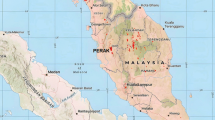Abstract
Data on the conservation status of 167 species of flowering plants presented here are from two representative sectors in south India: (a) the lowlands, characterized by dry deciduous vegetation representative of the Deccan plateau, as also a cluster of eight low altitude hill ranges [to 1200 (1500) m] of the southernmost reaches of the Eastern Ghats of India, and coastlands including mangroves; and (b) the hills, the high altitude hill ranges (to 2475 m) of the Palni hills, an eastward spur of the Western Ghats of India, characterized by evergreen vegetation but largely decimated around the hill station of Kodaikanal with the invasion of alien species since the l840s with the arrival of overseas colonial personnel and the raising of commercial monoculture plantations. Data for the 167 species are entered in 7 + 1 columns for the two regions separately. However, the IUCN red list categories are not used in their entirety for two reasons: (i) the areas are relatively small; (ii) the stress comes more from extrinsic causes like habitat destruction and over-exploitation rather than intrinsic (genetic) causes. However, it is stressed that what is happening over restricted areas over short time intervals is a miniature of what is happening over larger areas over longer periods, and hence these data are vitally important in planning for conservation and eco-restoration. The quality and quantity of new information are decisive; the findings are discussed under nine heads, as the first synthesis of results obtained from over two decades of field work.
Similar content being viewed by others
References
Balachandran N and Gastmans WF (1998) A complete description of rare and endangered Derris ovalifolia (Wight & Arn.) Benth. (Fabaceae), rediscovered from Pondicherry, South India. J. Econ. Taxon. Bot. 21: 615–618
IUCN (1994) IUCN Red List Categories. IUCN Council. Gland, 21 pp
Mathew KT (1992) Hoya wightii Hook.f. ssp. palniensis K. T. Mathew. Hoyan 14(2): 3–5
Matthew KM (1969) The exotic flora of Kodaikanal, Palni hills. Rec. Bot. Surv. India 20(1): 1–241
Matthew KM (1981) Materials for a Flora of the Tamilnadu Carnatic. Rapinat Herbarium, Tiruchirapalli
Matthew KM (1982) Illustrations on the Flora of the Tamilnadu Carnatic. Rapinat Herbarium, Tiruchirapalli
Matthew KM (1983) The Flora of the Tamilnadu Carnatic. Rapinat Herbarium, Tiruchirapalli (3 parts)
Matthew KM (1988) Further Illustrations on the Flora of the Tamilnadu Carnatic. Rapinat Herbarium, Tiruchirapalli
Matthew KM (1990) The flora of the upper Palnis and Kodaikanal. In: Kodaikanal (Boat club centenary commemoration volume). (Anon.) 42–52. Boat Club, Kodaikanal
Matthew KM (1991) Notes on the distribution of Bentinckia condapanna on the Palni hills in peninsular India. Principes 35(3): 139–141
Matthew KM (1993) Precursory notes on the flora of the Palni (Pulney) hills, South India: II. Kew Bulletin 48: 757–765
Matthew KM(1994) A Handbook of the Anglade Institute of Natural History, Shembaganur. (ed.2) Rapinat Herbarium, Tiruchirapalli
Matthew KM (1996a) Precursory notes on the flora of the Palni (Pulney) hills, South India - III J. Econ. Taxon. Bot. 20: 1–14
Matthew KM (1996b) Palni hills programme. Plant Conservation News (London) 3: 5
Matthew KM (1996c) The distribution of the little-known and rare Derris ovalifolia (LEGUMINOSAEPapilionoideae) extended. Kew Bulletin 51: 561–563
Matthew KM (1999) The Flora of the Palni hills (in press). Rapinat Herbarium, Tiruchirapalli
Matthew KM, Blasco F and Ignacimuthu S (1976) Biological changes at Kodaikanal, 1949- 74. Tropical Ecology 16: 147–162
Matthew KM, Britto S John and Rani N (1983) Some rare plants of the Tamilnadu Carnatic. In: Jain SK and Rao RR (eds) An Assessment of Threatened Plants of India. Botanical Survey of India, Howrah
Matthew KM and Mathew KT (1993) The flora of the Palni hills: a conservational situation report. In: Karunakaran CVK (ed) Proceedings of the Symposium on Rare, Endangered and Endemic Plants of the Western Ghats, pp 159–166. Kerala Forest Department, Thiruvananthapuram
Sharma M and Babu CR (1996) Indian subcontinent plant specialist group: Action plans and conservation priorities. Species 26- 27: 108–109
Stewart RW and Balcar T (1996) Pambar Shola: A success story in conservation - I. Shola 17: 232–235
Stewart RW and Balcar T (1997) Pambar Shola: A success story in conservation - II. Shola 20: 267–268
Author information
Authors and Affiliations
Rights and permissions
About this article
Cite this article
Matthew, K.M. A report on the conservation status of south Indian plants. Biodiversity and Conservation 8, 779–796 (1999). https://doi.org/10.1023/A:1008804029859
Issue Date:
DOI: https://doi.org/10.1023/A:1008804029859




